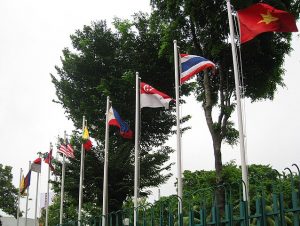Last week, the Institute for Southeast Asian Studies (ISEAS) released the latest iteration of a survey of Southeast Asian elites. Beyond the findings themselves, the survey spotlighted the broader question of how elite and mass opinion matters when it comes to major power competition in Southeast Asia as well as foreign policy calculations more generally.
Within the academic literature on public opinion – whether one speaks of mass opinion or elite opinion – there are contending views on various aspects, including how public opinion is formed and how responsive it is to changing developments. But there is nonetheless a general recognition that even though other factors such as power and geography are important realities to recognize as well, public opinion can drive, shape, and constrain foreign policy decisions based on various factors including regime type and the issue in question.
Major power competition in Southeast Asia is not immune to this. We have seen instances where this has been the case historically, be it the struggle that Indonesia faced in furthering counterterrorism collaboration with the George W. Bush administration amid rising negative popular sentiment during the Iraq War or the Vietnamese government’s attempts to manage disputes with China amid popular discontent as we’ve seen occasionally in the past few years including during the 2014 oil rig crisis. And elite and mass opinion continues to be scrutinized today for a clearer sense as to what the subregion thinks about broader questions, be it the Indo-Pacific concept or ongoing U.S.-China competition.
One of the few comprehensive attempts to measure elite opinion with respect to major powers in Southeast Asia is the survey conducted by ISEAS. The poll has been carried out over the past few years, which is important because it provides a basis for comparison over time and offers a regional take on questions apart from regular polling already being conducted by organizations including Pew, Gallup, as well as think tanks such as the Center for Strategic and International Studies.
The survey includes some interesting findings with respect to major powers that matter for their own sake. These include, among others, Japan being the most trusted major power in Southeast Asia (61 percent said they had confidence in Japan to do the right thing, making it the only power to reach a majority percentage); a rising recognition of China’s growing influence amid concern (52.2 percent said China was the region’s biggest source of political and strategic influence and 85.4 percent said this was a worrying trend); and a split between the United States and China if countries were to be forced to choose (53.6 percent for the U.S. versus 46.4 percent for China).
But the findings and the survey more generally also factor into the broader question of how major powers are being perceived in Southeast Asia. On the one hand, there is confirmation of some aspects of conventional wisdom, such as China’s growing influence and concerns about U.S. presence. But on the other hand, the findings challenge other aspects of conventional wisdom and the narrow frame of major power competition more generally, such as the limitations of a binary U.S.-China prism (which does not account for the trustworthiness of Japan and the recognition of the EU’s role on trade and the rules-based order); the continued preoccupation with domestic concerns (the top three security concerns in the survey were domestic political instability, economic downturn, and climate change); and the recognition of ASEAN as an important institution in spite of mixed feelings about its relationship with common people, ability to manage growing major power competition, and actually managing issues such as the Rakhine crisis.
To be sure, there are limits to the significance of these findings as with any survey and public opinion more generally. For one, statistics can be used selectively to argue different positions (while the region’s growing recognition of China might be an indicator that Beijing is making inroads, this also coexists with rising distrust). For another, certain indications of sentiment do not tell us why individuals felt this way and why their feelings may have changed (for instance, while one might attribute the growing reception of the Indo-Pacific concept to factors such as ASEAN’s own release of its Indo-Pacific Outlook as a grouping, that cannot actually be confirmed without more specific focus group sessions).
More broadly, elite opinion is also only one aspect of regional perceptions, and a full understanding of these perceptions would also take into account how elite perceptions converge or diverge with popular perceptions, and the extent to which they are actually affecting policy. As a case in point, the complex interaction of these factors in the Philippines’s approach to China under Rodrigo Duterte’s presidency is an important reminder of this reality. And while it is important not to understate the importance of public opinion, it is important not to overstate it either amid other important factors such as power as well as how quickly these perceptions can change over time (with respect to the U.S. role, for example, a part of current perceptions are tied to U.S. President Donald Trump, and 60.3 percent of respondents said a change of leadership would shift their level of confidence).
That said, given Southeast Asia’s continued importance as a locus for major power competition, one can expect the scrutiny on elite and mass opinion in the region to continue in years to come. And surveys such as the one from ISEAS will be key to consult in order to periodically assess aspects of continuity and change regarding Southeast Asia’s perceptions in this regard.

































